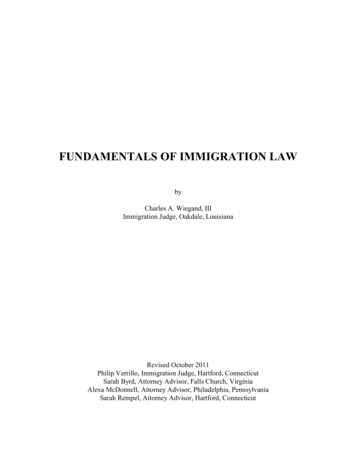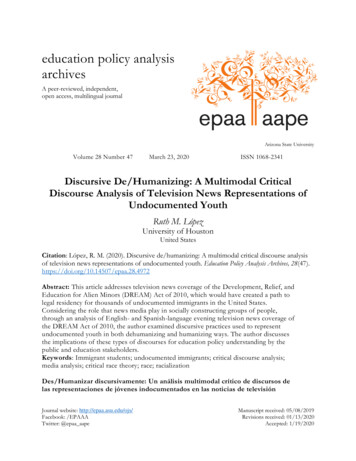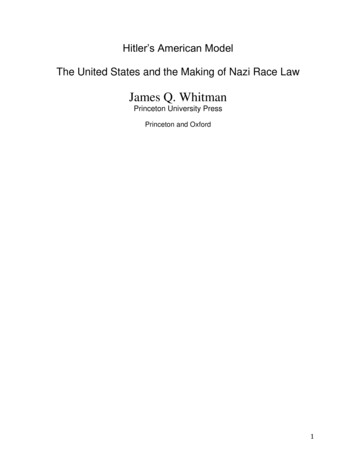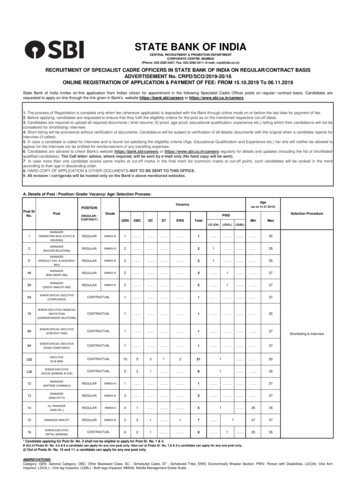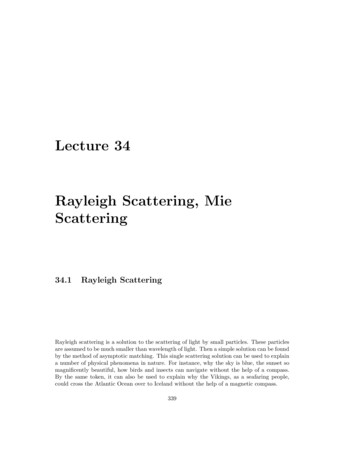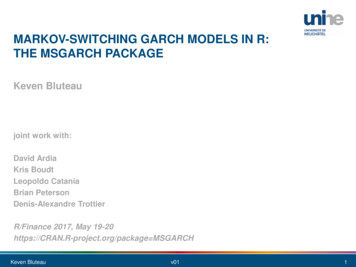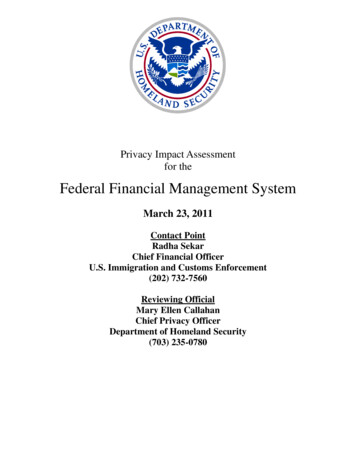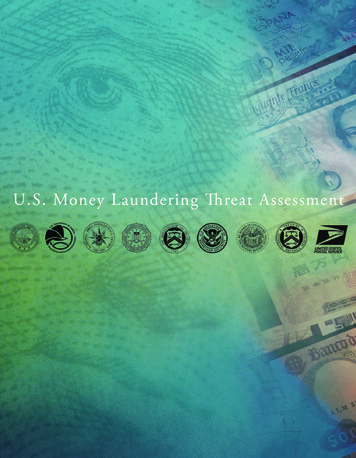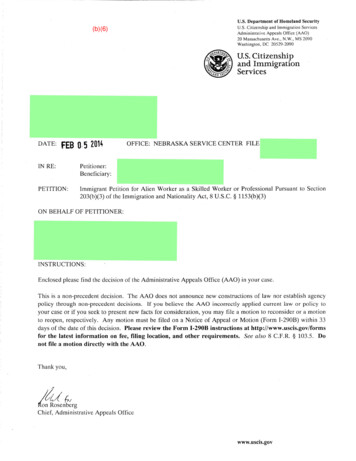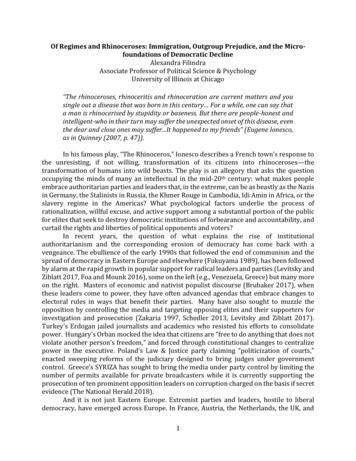
Transcription
Of Regimes and Rhinoceroses: Immigration, Outgroup Prejudice, and the Microfoundations of Democratic DeclineAlexandra FilindraAssociate Professor of Political Science & PsychologyUniversity of Illinois at Chicago“The rhinoceroses, rhinoceritis and rhinoceration are current matters and yousingle out a disease that was born in this century For a while, one can say thata man is rhinocerised by stupidity or baseness. But there are people-honest andintelligent-who in their turn may suffer the unexpected onset of this disease, eventhe dear and close ones may suffer.It happened to my friends” (Eugene Ionesco,as in Quinney (2007, p. 47)).In his famous play, “The Rhinoceros,” Ionesco describes a French town’s response tothe unresisting, if not willing, transformation of its citizens into rhinoceroses—thetransformation of humans into wild beasts. The play is an allegory that asks the questionoccupying the minds of many an intellectual in the mid-20th century: what makes peopleembrace authoritarian parties and leaders that, in the extreme, can be as beastly as the Nazisin Germany, the Stalinists in Russia, the Khmer Rouge in Cambodia, Idi Amin in Africa, or theslavery regime in the Americas? What psychological factors underlie the process ofrationalization, willful excuse, and active support among a substantial portion of the publicfor elites that seek to destroy democratic institutions of forbearance and accountability, andcurtail the rights and liberties of political opponents and voters?In recent years, the question of what explains the rise of institutionalauthoritarianism and the corresponding erosion of democracy has come back with avengeance. The ebullience of the early 1990s that followed the end of communism and thespread of democracy in Eastern Europe and elsewhere (Fukuyama 1989), has been followedby alarm at the rapid growth in popular support for radical leaders and parties (Levitsky andZiblatt 2017, Foa and Mounk 2016), some on the left (e.g., Venezuela, Greece) but many moreon the right. Masters of economic and nativist populist discourse (Brubaker 2017), whenthese leaders come to power, they have often advanced agendas that embrace changes toelectoral rules in ways that benefit their parties. Many have also sought to muzzle theopposition by controlling the media and targeting opposing elites and their supporters forinvestigation and prosecution (Zakaria 1997, Schedler 2013, Levitsky and Ziblatt 2017).Turkey’s Erdogan jailed journalists and academics who resisted his efforts to consolidatepower. Hungary’s Orban mocked the idea that citizens are “free to do anything that does notviolate another person’s freedom,” and forced through constitutional changes to centralizepower in the executive. Poland’s Law & Justice party claiming “politicization of courts,”enacted sweeping reforms of the judiciary designed to bring judges under governmentcontrol. Greece’s SYRIZA has sought to bring the media under party control by limiting thenumber of permits available for private broadcasters while it is currently supporting theprosecution of ten prominent opposition leaders on corruption charged on the basis if secretevidence (The National Herald 2018).And it is not just Eastern Europe. Extremist parties and leaders, hostile to liberaldemocracy, have emerged across Europe. In France, Austria, the Netherlands, the UK, and1
elsewhere parties that promise to prevent and even reverse immigration, close the bordersto outsides, and “de-islamize” and restore ethnoreligious homogeneity to their societies(Said-Moorhouse and Jones 2017), have become strong contenders for government either asleaders or as coalition partners. In addition to civil rights for minorities, other institutionsof liberal democracy have become implicit or explicit targets. Even the world’s oldestdemocracy is not immune to the allure of an exclusionary, organic “people” led by a populiststrongman who claims to be above the law.The rise of Donald Trump has been accompanied by the blatant disregard if notcontempt for the country’s egalitarian social norms, the politicization of the administrativestate (e.g., claims of disloyalty against the Department of Justice and national lawenforcement, and calls for the Post Office to charge higher rates to Washington Post owner,Amazon), and efforts to change electoral rules and even the composition of high courts tocement party advantages and prevent the opposition from gaining ground. From extremegerrymandering, to voter-ID laws, to proposed constitutional amendments to exclude noncitizens from the official population count or the latest proposal for U.S. Censusquestionnaire changes meant to impact apportionment, to calls for the impeachment,replacement, or “packing” of state high courts issuing decisions that political leaders dislike,the U.S. has witnessed it all in the span of a decade.The President, when he is not busy inciting chants of “lock her [Hillary Clinton] up!”among his supporters, has been excluding media from state functions and issuing openthreats against journalists, state functionaries, and even judges, on social media. Trumpistelites at the federal and state levels have followed suit. More recently, such “fighting dirty”tactics have been endorsed by supporters of the Left who argue that their policy agenda andthe rights of the people can only be safeguarded by exploiting institutional openings to createa one-party state of the other persuasion (Faris 2018).Building on Juan Linz and Alfred Stepan’s classic studies (1978), much of the recentliterature has focused on the institutional and discursive strategies that elites have used toundermine liberal democracy (Levitsky and Ziblatt 2017, Sunstein 2018, Brubaker 2017).These top-down processes are very important in answering the questions of when and howelites may move against democratic norms and institutions. However, all regimes, includingauthoritarian systems require support from a substantial portion of the public. It is fromcitizens that regimes draw legitimacy, recruits, voters, and defenders. It is the abandonmentof democratic principle, and sometimes of humanity itself, among citizens that enablesextremists, populists, and demagogues of all persuasions to reach and hold on to power.Which brings us to the question that was central to Ionesco’s allegory: what drives ordinarypeople, to willingly become rhinoceroses?I argue that social identities based on race, ethnicity, language, or religion, the waythey have become intertwined with political and partisan identities, and the politics thatsurround them threaten to upend democratic polities. In the context of increased socialdiversity, portions of the public is willing to support calls for an exclusionary moralcommunity of virtue at the expense of norms and institutions of democracy. Contrary to ouridealistic normative assumptions, citizens do not have a principled or ideologicallyconstrained approach to democracy any more than they have a principled approach togovernance and policy (Converse 1964). Rather, they are prone to understand democracythrough the lens of group memberships. When the social position of cherished groups isperceived as threatened, and when trusted in-group elites use narratives of group threat and2
out-group dehumanization to justify anti-democratic actions, group members become morevulnerable to authoritarian leaders and parties that promise protection or restoration of thegroup’s status but at the cost of institutional democracy.The Prejudice Hypothesis: Rhinoceritis as AcquiredIn the American context, beliefs about the role, scope, and character of governmenthave been and continue to be filtered through the prism of race and alienage with class biasesserving to amplify negative group perceptions. Since its inception, the United States has beendeeply ambivalent about the breadth and depth of inclusion that it should allow andencourage for aliens and minority groups, at times supporting highly anti-democratic lawsin the name of protecting the “national character.” From Jefferson’s concerns that theeconomic dependence of the immigrant working poor (let alone the emancipation and ofblack slaves) would open the door for corruption and tyranny, to Ben Franklin’s fears thatnew immigrants would “Germanize” the character of the country’s English inhabitants, toTrump’s “Muslim ban,” there is a long tradition of white American elites and their numerousfollowers who have supported various forms of repression and un-freedom in the name ofprotecting the nation and the polity.Debates over the power that should be allotted to branches of the nationalgovernment (executive v. legislative) and levels of government (federal v. states), have oftenbeen triggered by or framed in terms of who is best suited to manage and control the enemieswithin and protect the “true” Americans from all manner of harm (Pickus 2005, Key 1949,King 2002). Not surprisingly, over time, the United States has hosted multiple andoverlapping political regimes that concurrently but differentially governed (and continue todo so, especially in the case of immigrants) categories of people based primarily (sometimesimplicitly) on ascriptive criteria (Smith 1997, Key 1949, Pickus 2005, Mickey 2015).Democratic institutions in the American South co-existed with a harsh authoritarianregime that governed the lives of black slaves; both were sustained by the ideology of whitesupremacy which cultivated equality and social trust among whites from across socialclasses and nativity lines while at the same time maximizing social and political distancebetween whites and blacks (Mickey 2015, Roediger 2003, Cash 1941). After the Civil Warand Reconstruction, the nominal elevation of slaves to national citizenship was accompaniedby the undemocratic system of social and residential segregation which took roots acrossthe country, effectively nationalizing Southern authoritarianism (Sugrue 1995, Klinker andSmith 2002).Starting in the 1850s and culminating in the 1920s, the same ideological and socialdynamics served as the basis for an exclusionary immigration regime which usedAnglosaxon whiteness (variedly defined over time) as the main criterion for immigrantadmission. Nativism and racism provided the justification for the exclusion of a variety ofimmigrant groups (especially Asians but also Latinos) from political and civil rights andliberties ensuring that race and alienage status determined the level of democracy oneexperienced. Populism, the language of Southern politics, devised to justify the “union offreedom and slavery” (Patterson 1999), became the rhetorical structure that various nativistand racist elites used to justify curtailing democratic rights and abandoning norms. In onkey strand of American populist discourse, those fighting on the side of racial egalitarianismwere portrayed as corrupt, un-American, “communist” elites seeking to destroy Americandemocracy.3
In the Southern system, we see the strongest evidence that beliefs in democracy maynot be principled but rather directional. Southern leaders and their followers perceived nocontradiction between individual liberty and chattel slavery and “white southern celebrationof liberty always included the freedom to preserve black slavery” (Cooper 2000, 35). Freeelections and egalitarian political institutions for whites were embraced, as leaders forged apersonal bond with followers based on their common whiteness which enabled elites to usegovernment in defense of an aristocratic, doulotic, social order. In this world, representativegovernment institutions were not inherently a threat: only when centralized outside thisclosed political system and led by individuals who did not accept the beneficence of the“peculiar institution” did democratic government become a threat to individual rights andspecifically to the “natural” right of owning human beings as property (Ericson 2000, Faust1981).The Civil War may have ended slavery but it nationalized the ideology and institutionsof white supremacy under the banner of “states’ rights.” States’ rights ideology whichoriginated with Southern Democrats but was embraced by Republicans after the New Dealand the Civil Rights Movement, fused Northern libertarian individualism which emphasizedgovernment restraint with Southern racial fears and prejudices (Schickler 2016, Filindra andKaplan 2018, Lowndes 2008). Together they sculpted a color-blind, but heavily racialized,populist narrative according to which the rights of a broad virtuous group, such as “thehomeowners,” “the moral (or silent) majority,” “the law abiding citizens,” “the trueAmericans,” or “the taxpayers,” were being threatened because government elites werecolluding with undeserving groups such as “criminals,” “welfare queens,” “extremists,”“illegals,” “anchor babies,” or “terrorists,” granting them “special rights” in exchange forpolitical power (Filindra and Kaplan 2016, Hosang 2010, Dudas 2008). Governmentinstitutions tasked with protecting vulnerable populations and providing checks on thepower of political elites and dominant social groups have been transformed into the “DeepState” whose goal is to disempower “the people.” As Orlando Patterson (1999) has noted, theheirs to Southern herrenvolk democracy sought to generate and sustain white anti-blackresentment towards national institutions and leaders by “making niggers of liberals, theidentification of the “N” word with the “L” word” (p. 178).Of Rhinoceroses and TrumpismThis is the context in which we can begin to understand the “Trump effect” and similarphenomena across the West, and assess their seriousness. Here are the key questions toexplore:1. Are we experiencing a “crisis in confidence” in, if not an erosion of support fordemocratic institutions in the U.S. today?2. Is such a crisis linked to outgroup fears such as racism and nativism?3. Is Trump the cause of this crisis, a “charismatic” demagogue who managed to awakethe sleeping dragon, or is he the heir of long-standing efforts by racial conservatives toundermine democratic institutions and trust in government?Crisis in Confidence & Support for Non-democratic SolutionsAs far back as the 1990s, political scientists sounded the alarm that trust ingovernment institutions has been in precipitous decline across Western democracies(Warren 1999, Hetherington 2005, Inglehart 1999, Nye 1997). These trends exist among4
both majority and minority social groups, but our focus here is on whites because of thedisproportionately powerful role they play in American politics. A humorous poll from 2013found that white Americans had a higher opinion of witches (49% v. 32%), dog poop (42%v. 34%), and the hated DMV (48% v. 28%) than they did of the U.S. Congress (Public PolicyPolling 2013).Other data suggest that it is not only trust but a variety of other attitudes towardsgovernment and its institutions that may have changed for the worst in the past four decades.First, white Americans have abandoned New Deal ideals, and have increasingly adoptedideologies that accommodate a state as the “night watchman.” According to data from theANES, in 1992, 44 percent of whites supported a greater role of government in society andthe economy; by 2016 only 28 percent felt the same way. Second, whites have come toperceive their government as a threat rather than as a protector. In 2008, the first time thisquestion was asked in the ANES, half of all whites believed that government constitutes athreat to individual rights and liberties; four years later it had climbed to 60 percent.Data from the 2016 ANES suggest that the problem goes beyond mistrust in andfeelings of hostility towards government and its role in society. Significant proportions ofwhite America has embraced authoritarian populism. More than a third of whites endorsehaving a strong leader even if he bends the rules; half want a leader who will “crush evil” andtake us back to the “true path”; and just shy of a majority want the authorities to get rid of“rotten apples” who are ruining everything (Figure 1).Figure 1. Support for non-democratic norms (2016 ANES, whites only)Our country would be great if they honor the ways ofour forefathers, do what the authorities tell them todo, and get rid of the 'rotten apples' who are ruiningeverything.47%Our country really needs a strong, determined leaderwho will crush evil and take them back to their truepath.52%Having a strong leader in government is good for theUnited States even if the leader bends the rules to getthings done.37%An online survey of white Americans (n 1,200) that I conducted in March 2018confirms the troubling trends with some additional very disconcerting insights. These dataare not fully representative of the white population the way the ANES data are, but they domatch the general population in many demographic dimensions, so they are certainlydirectionally indicative of the mood and attitudes of the white public. Furthermore, thedistribution of responses on the item measuring whether government is a threat to freedoms5
is very similar to the ANES and other representative studies, so there is reason to think thatthese data are not wildly off the mark.There is little good to report here. The best news is that only a fifth of our whitecompatriots think that the President should shut down Congress and govern alone but twiceas many (38%) believe that under some circumstances, an unelected government ispreferred to an elected one. A similar proportion (39%) think that there are circumstancesthat would justify a military takeover of the American government (this is very close to whata 2015 YouGov Study reported). Almost half (45%) of white Americans believe that themedia have too much freedom in expressing political views, and more than half (55%) wouldlike a leader with an iron fist. Finally, 58% of our white compatriots think that the federalgovernment poses a threat to the rights and freedoms of citizens.Figure 2. Support for Anti-democratic Institutions & Norms (March 2018Qualtrics Survey)The federal government poses a threat tothe rights and freedoms of ordinary citizens58%Our country needs leaders with an iron fist55%The news media are allowed too muchfreedom in criticizing elected leaders45%Under some circumstances, it would bejustified for the military to take overgovernment39%Under some circumstances, an un-electedgovernment may be better than an electedone38%When things get tough, the President shouldshut down Congress and govern on his own21%Bringing the Rhinoceros into the Picture: Is the Anti-government and Anti-democracyTrend Driven by Outgroup Resentment?Historical analyses by numerous scholars of American political development haveprovided evidence that the linkage between out-group resentments and hostility towardsgovernment and its institutions is long standing (Schickler 2016, Key 1949, Lowndes 2008,Mickey 2015, Patterson 1999). Studies in political behavior confirm that whites haveembraced racial populism: perceptions about the scope and role of government, feelings ofthreat by the federal government, concerns about the fairness of elections, support for voteridentification laws, all are fueled by racial resentment (Appleby and Federico 2017, Filindraand Kaplan 2018, Wilson and Brewer 2013). This attitudinal link between racial resentmentand confidence in national institutions not only predates Trump, it also predates Obama. Ouranalyses with Noah Kaplan (2018) find that racial resentment and distrust in governmenthave been correlated as far back as 1988, the first instance when both measures are included6
in the National Election Survey. Buyuker (2018) shows that racial resentment as well as antiimmigrant attitudes contribute to dominant group enthusiasm for authoritarian populism.The partisan realignment which started with the New Deal and concluded with theObama presidency, brought racially resentful whites to the fold of the Republican partystrengthening the link between partisan and social identities, on one hand, and “affectivepartisanship” or negative feelings towards the out-party, on the other (Huddy, Mason, andAarØE 2015, Abramowitz and Webster 2018). The conservatives’ racialized hostility togovernment institutions and democratic norms was amplified and evangelized to newaudiences with the emergence of Fox News as the conservative movement’s megaphone(DellaVigna and Kaplan 2007, Schroeder and Stone 2015). The election of Barack Obama asthe country’s first black President further strengthened the role that racial grievances playin white Americans’ political judgements (Tesler and Sears 2010).The racial realignment coupled with a shift of extremist rhetoric from the margins ofthe conservative movement to the mainstream of the Republican Party (Levitsky and Ziblatt2017, Filindra and Kaplan 2018) have had a consequential effect on white public opinion.The increasingly negative rhetoric focused on the government and its institutions, thecharges that political opponents are “crooked,” “corrupt,” or agents of the “Deep state,” alongwith swirling conspiracy theories of all types, have served to link white racial attitudes toideas and beliefs related to democratic institutions.How can we assess the effects of this link? Below, I present descriptive analyses fromboth the 2016 ANES and the 2018 online survey. In both cases, I show preferences for antidemocratic norms and institutions by racial resentment and by partisan affiliation. Theracial resentment measure is a common measure of anti-black sentiment based on responsesto a battery of four questions (Kinder and Sanders 1996). According to recent analyses, theproportion of whites who can be classified as high racial resenters has hovered at the 60%mark for several decades (Kinder and Chudy 2016). Although the share of the generalpopulation that is white has been in decline since at least the 1970s due to immigration,white Americans continue to represent the majority (about 67%) of the total population.This suggests that about 40% of the American population today can be classified as highracial resenters.Figure 3 shows responses to the same three 2016 ANES items presented earlier butfor whites who score high on racial resentment and those who score low on racialresentment based on the mean. The differences in endorsement of authoritarian normsbetween these two groups is striking. Among those scoring high on racial resentment, 86%agree that a strong leader who on occasion bends the rules to get things done is not a badidea; only 15% of those who score low on racial resentment endorse this viewpoint. Asimilar proportion of high racial resenters (86%) believe that authorities should get rid ofthe rotten apples who ruin everything, while only 14% of low racial resenters agree withthat view. Almost four-in-five (79%) of high racial resenters believe that our country needsa strong leader who will crush evil, while only 21% of low racial resenters express similarbeliefs. All these differences are statistically significant (p 0.05).7
Figure 3. Support for non-democratic norms by level of racial resentment(2016 ANES, whites only)86%86%79%21%15%Having a strongleader in governmentis good for the UnitedStates even if theleader bends therules to get thingsdone.14%Our country reallyneeds a strong,determined leaderwho will crush eviland take them backto their true path.High Racial ResentmentOur country wouldbe great if they honorthe ways of ourforefathers, do whatthe authorities tellthem to do, and getrid of the 'rottenapples' who areruining everything.Low Racial ResentmentMy 2018 survey is not fully representative as the ANES is, but has an advantage: itincludes a range of attitudes about how political leaders should behave and what kinds ofactions are appropriate. In the terms used by Levitsky and Ziblatt (2017), these questionsseek to identify whether racial resentment drives whites to abandon support for norms offorbearance and tolerance. The survey also includes the measure of racial resentment.Figure 4, shows differences in preferences for a variety of anti-democratic politicalnorms and institutions for those who score high on racial resentment and those who scorelow on this measure. The news are not good for either group as substantial numbers of bothhigh and low racial resenters—many more low resenters than in the case of the ANESquestions—are prepared to endorse highly anti-democratic institutional and normativechanges. However, those scoring high on racial resentment are significantly more likely,often two times more likely, than our less resentful neighbors to harbor such extreme beliefs.In all cases, the differences between the two groups are statistically significant(p 0.05). As the first set of bars shows, two-thirds (65%) of those who score high on racialresentment endorse authoritarian leadership and believe that “the country needs a leaderwith an iron fist,” compared to half as many (33%) of those scoring low on this measure. Asimilar proportion of high racial resenters (63%) compared to 46% of those scoring low onracial bias believe that the federal government poses a threat to the rights of ordinarycitizens. Whites who score high on racial resentment (54%, compared to 24% of lowresenters) tend to harbor more negative beliefs about the news media, thinking that themedia are allowed too much freedom in their criticism of elected leaders. The hostility8
towards media that has increased exponentially during the Trump era constitutes a majorthreat to democracy which requires faith in the fourth estate to function properly. Four-inten among those who are highly resentful of blacks (42%) compared to 31% of those whoare low resenters are ready to endorse a military junta “under some circumstances.” This ina country with a long-standing skepticism of professional armies which has traditionallyimposed strict civilian control over the military (Uviller and Merkel 2003).Figure 4. Support for Non-Democratic Politics by Racial try needsThe federalThe news media areleaders with iron fist government poses a allowed too much(Item 11)threat to the rights freedom in criticizingand freedoms of elected leaders (Itemordinary citizens16)(Item 9)High Racial Resentment (RR 0.5)Under someUnder somePresident should shutcircumstancescircumstances,down Congress andmilitary takeover unelected govt better govern on his ownjustified (Item 12)than elected (Item(Item 13)10)Low Racial Resentment (RR 0.5)A similar proportion of highly racially resentful whites (42%) compared to 30% oftheir least resentful peers are prepared to accept that under some circumstances electionsare not the best way and an unelected government might be superior. These beliefs run sodeeply contrary to the American political tradition that these numbers are quite alarming.Although less popular, a quarter of high racial resenters (26%) compared to only 12% of lowresenters are ready to accept a president who shuts down Congress and governs on hisown—an unaccountable dictator.Is Trump the Cause or the Effect?Trump did not cause this strong connection between racial attitudes and beliefs aboutgovernment and institutional democratic norms. Analyses that Noah Kaplan and I haveconducted using the ANES data suggest that trust in government among whites wasnegatively influenced by racial resentment as far back as 1988, while beliefs about the sizeof government became racialized in a similar way in the early 2000 at the time when FoxNews became a major player on the Right (Filindra and Kaplan 2018). The trend continuedunabated through the Obama era; during this period, we have evidence that racially resentfulwhites expressed less positive affect for the federal government (as measured by the feelingthermometer). Furthermore, racially resentful whites have come to believe that the nationalgovernment represents a threat to individual rights. Although not discussed in terms ofdemocracy and its norms and institutions, other studies have pointed in the same direction.9
Appleby and Federico (2017) show that perceptions of electoral fairness are colored byracial resentment, while Wilson and Brewer (2013) indicate that racial resentment is adriver in white support of the new crops of restrictive Voter ID laws that introduce a varietyof barriers to vote that differentially impact minorities. Buyuker (2018) shows that bothracial resentment and anti-immigrant attitudes drive white Americans’ support for antidemocratic norms, such as support for strong leaders who will get rid of “rotten apples”.Miller and Davis (2018) report similar results using multiple waves of the World ValuesSurvey, suggesting that a link between white out-group hostility, measured in terms ofdesired social distance from groups such as immigrants, Muslims, or blacks (among manyother stigmatized groups), and anti-democratic tendencies can be found as early as 1995,long before Trump came to the forefront of national politics.There is no doubt that Trump, the chief “birther” and a major propagator of rightwingconspiracy theories, capitalized on racial resentment and mobilized white social identitiesin ways that “establishment” Republicans (save perhaps for Newt Gingrich and RudyGiuliani) were not willing to do. His rhetoric, unconstrained by the training that comes fromlong-term partisan socialization, relied on overt racial themes targeting Latinos, blacks,Muslims, and immigrants. He portrayed a country in decline characterized by internal“carnage,” characterized immigrants as “animals” or people from “hellhole nations” that donot deserve a place in American society, and promoted exclusion and xenophobia as themeans to “Make America Great Again.”Quo Vadis?So where do we go from here? The Trump presidency will end. From the vantagepoint of May 2018, we can’t know if it will end before 2020, in 2020, or in 2024. But we knowit will end. Does th
prosecution of ten prominent opposition leaders on corruption charged on the basis if secret evidence (The National Herald 2018). And it is not just Eastern Europe. Extremist parties and leaders, hostile to liberal democracy, have emerged across
